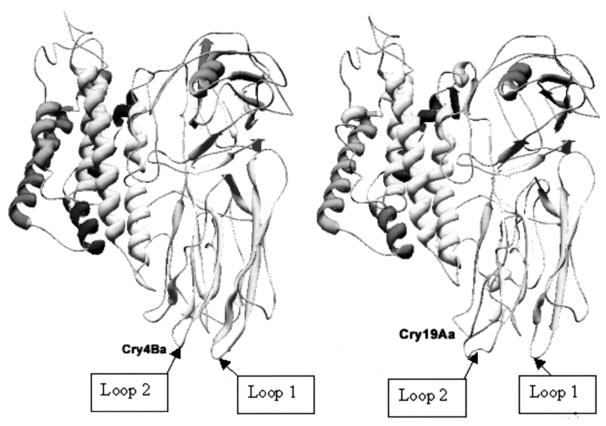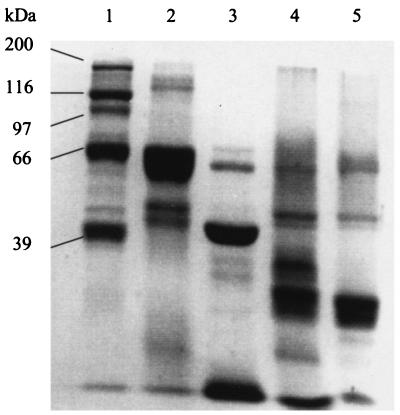Abstract
Improvements in the mosquitocidal activity of Bacillus thuringiensis Cry19Aa were achieved by protein engineering of putative surface loop residues in domain II through rational design. The improvement of Aedes toxicity in Cry19Aa was 42,000-fold and did not affect its toxicity against Anopheles or Culex.
Protein engineering of Cry toxins has been demonstrated to have potential for enhancing toxicity (1, 2, 11). Although the comprehensive understanding of the molecular mechanism of action of Cry toxins, especially for mosquitocidal toxins, is still at its early stages, some useful information is available. For example, some receptor-binding epitopes have been mapped to domain II of the toxin, and in certain cases an increase in binding to receptors translates into an increase in toxicity (1, 2, 4). Thus, site-directed mutagenesis targeted at domain II of Cry toxins to increase receptor binding appears to be a rational approach to increase toxicity.
Bacillus thuringiensis serotype H-14 is a commercial mosquitocidal strain that contains three active toxins, Cry4Aa, Cry4Ba, and Cry11Aa, and a cytolytic toxin, Cyt1Aa (9). The Cry4Aa toxin has low activity against all three major genera of mosquitoes, Aedes, Anopheles, and Culex, while Cry4Ba has higher toxicity against Aedes and Anopheles but no activity against Culex. Cry11Aa has higher toxicity than CryAa against all three genera of mosquitoes. Another serotype of B. thuringiensis, H-28a28c, produced seven major polypeptides that are different from those produced in B. thuringiensis serotype H-14 (7). One of the Cry toxins produced in the H-28a28c serotype is Cry19Aa, the gene for which has been isolated, sequenced, and expressed (8). Cry19Aa is toxic to Anopheles stephensi and Culex pipiens but has no measurable activity against Aedes aegypti (8). Also, there is less cross-resistance to Cry19Aa in Culex resistant to Cry4Aa, Cry4Ba, and Cry11Aa (10). This property would be very useful in resistance management strategies. However, resistance to this serotype has not been reported to develop.
Previously, we discovered that the incorporation of an important putative loop sequence from Cry4Aa augmented the activity of Cry4Ba against Culex (1). These experiments suggested that residues in putative loops 1 and 2 of Cry4Ba were involved with Anopheles and Aedes toxicities. Similar to the loop exchange experiment with Cry4Ba, it is possible that replacing the putative loop 1 and 2 residues of Cry19Aa with nonhomologous residues from Cry4Ba could confer anti-Aedes activity on Cry19Aa. Thus, the objective of this study was to test the hypothesis that Aedes toxicity could be transferred to Cry19Aa by exchanging the loop regions of domain II to mimic Cry4Ba.
Homology modeling, as described elsewhere (1, 3, 5, 6), was done to obtain model structures of Cry4Ba (with Cry3Aa and Cry4Aa as templates) and Cry19Aa (with the derived Cry4Ba as a template). The two model structures were aligned using Swiss-Pdb Viewer, and the residues in domain II loops were noted. Loop residues of Cry19Aa were replaced with loop residues of Cry4Ba by site-directed mutagenesis.
Model structures of both toxins are shown in Fig. 1, and the root mean square deviation was determined to be 0.39 Å. This suggested that the overall structure was very similar even though the homology of the primary sequences was very low (less than 30%). Part of the primary structure alignment of domain II contains loops (Fig. 2). The positions of loop structures in domain II of Cry4Ba and Cry19Aa, as well as the amino acid residues making up the loops, are indicated in the alignment.
FIG. 1.
Ribbon representation of model structures of Cry4Ba (left) and Cry19Aa (right). The arrows indicate the positions of the putative loop regions of domain II.
FIG. 2.
Sequence alignments based on the model structures made with Swiss-Pdb Viewer of Cry4Ba with Cry19Aa. Putative loop positions are indicated on top of the sequences, while the amino acid residues that were mutated are underlined.
In the putative loop 1 of Cry19Aa, 355SYWT358 was mutated to YQDLR by the QuickChange method (Stratagene) as previously described (1), while in the putative loop 2 414YPWGD418 was deleted. Primer sequences and methods are available upon request. These mutations, according to the model structures, mimicked the residues in putative loop 1 and the length of putative loop 2 of Cry4Ba. This mutant was called 19AL1L2. Bioassays of second-instar mosquito larvae were done as previously described (1) to test the mosquitocidal activities of the wild-type Cry19Aa and the mutein. The results in Table 1 indicate that the mutations enhanced the Cry19Aa activity against A. aegypti by more than 42,000-fold. This enhancement was achieved without significant loss of toxicity toward the Anopheles and Culex species tested. However, preliminary experiments indicated that loop 1 or loop 2 exchanges alone did not produce toxicity against A. aegypti (data not shown).
TABLE 1.
Bioassay results for four species of mosquitoes
| Toxin | LC50 (ng/ml)a
|
|||
|---|---|---|---|---|
| Anopheles quadrimaculatus | A. aegypti | Culex quinquefasciatus | C. pipiens | |
| Cry19Aa | 3.0 (2.0-4.4) | 1.4 × 105 (0.4-103) | 35 (22-52) | 6 (3-9) |
| 19AL1L2 | 2.2 (2.2-2.3) | 3.3 (3.1-3.5) | 19 (11-32) | 5 (1-10) |
Two-day-old larvae of A. aegypti, C. quinquefasciatus, and C. pipiens and 3-day-old larvae of A. quadrimaculatus were used for bioassays. Mortality was recorded after 24 h of exposure to a serial dilution of the toxins. The 95% confidence limit is indicated in parentheses. Bioassays used inclusion crystal proteins and spores purified from B. thuringiensis. LC50, 50% lethal concentration.
The trypsin processing of Cry19Aa and 19AL1L2 showed different patterns, as shown in Fig. 3. The protoxin forms of Cry19Aa (Fig. 3, lane 2) and 19AL1L2 (Fig. 3, lane 3) indicated that the mutations made in loop 1 and loop 2 made 19AL1L2 susceptible to an additional cleavage by bacterial host proteases, as indicated by a distinct band at 39 kDa (Fig. 3, lane 3). This did not weaken its toxicity towards the tested mosquitoes. Gel filtration by high-pressure liquid chromatography of the trypsin-activated toxins indicated that the toxins had a molecular size of about 66 kDa (data not shown). This suggests that the toxins, although digested by trypsin, formed stable complexes in nondenaturing conditions.
FIG. 3.
Sodium dodecyl sulfate-polyacrylamide gel electrophoresis of high-pressure liquid chromatography-purified non-trypsin-activated and trypsin-activated toxins. Lanes: 1, marker; 2, Cry19Aa, non-trypsin activated; 3, Cry19AL1L2, non-trypsin activated; 4, 19Aa, trypsin activated; 5, 19AL1L2, trypsin activated.
The abilities of the wild-type and mutant toxins to reversibly bind to the brush border membrane vesicles (BBMV) of A. aegypti were tested by competition binding assays of Cry19Aa and 19AL1L2, according to previously described methods (1). The results (data not shown) indicated that there was no significant difference in the ability to reversibly bind the BBMV for both the least-active wild-type Cry19Aa and the active 19AL1L2. There was also no significant difference in the abilities of the toxins to irreversibly bind to the BBMV (data not shown). These results suggested either that the assay was flawed, perhaps in using BBMV prepared from whole larvae, or that the enhanced anti-Aedes activity of the Cry19Aa mutant was not correlated with receptor binding or membrane insertion. The results from binding studies of Cry19Aa and its enhanced mutein were similar to the binding results for Cry4Ba and its mutein in our previous study (1). We have presented a model that accounts for the lack of correlation of binding and toxicity (1). According to this model the nontoxic wild-type Cry toxin binds irreversibly to BBMV surface proteins but does not elicit toxicity. The enhanced-toxicity mutant toxins are able to bind to a unique and minor class of binding proteins (receptors) that evoke toxicity. We suggest that this might be the case with Cry19Aa enhanced-toxicity mutants as well.
In conclusion, we have shown that Cry19Aa was enhanced more than 42,000-fold in toxicity for A. aegypti while still maintaining its activities against Anopheles and Culex. This is the highest increase in toxicity by protein engineering reported for a Cry toxin to date.
REFERENCES
- 1.Abdullah, M. A. F., O. Alzate, M. Mohammad, R. J. McNall, M. J. Adang, and D. H. Dean. 2003. Introduction of Culex toxicity into Bacillus thuringiensis Cry4Ba by protein engineering. Appl. Environ. Microbiol. 69:5343-5353. [DOI] [PMC free article] [PubMed] [Google Scholar]
- 2.Dean, D. H., F. Rajamohan, M. K. Lee, S.-J. Wu, X.-J. Chen, E. Alcantara, and S. R. Hussain. 1996. Probing the mechanism of action of Bacillus thuringiensis insecticidal proteins by site-directed mutagenesis. Gene 179:111-117. [DOI] [PubMed] [Google Scholar]
- 3.Guex, N., and M. C. Peitsch. 1997. SWISS-MODEL and the Swiss-Pdb Viewer: an environment for comparative protein modeling. Electrophoresis 18:2714-2723. [DOI] [PubMed] [Google Scholar]
- 4.Lu, H., F. Rajamohan, and D. H. Dean. 1994. Identification of amino acid residues of Bacillus thuringiensis δ-endotoxin CryIAa associated with membrane binding and toxicity to Bombyx mori. J. Bacteriol. 176:5554-5559. [DOI] [PMC free article] [PubMed] [Google Scholar]
- 5.Peitsch, M. C. 1996. ProMod and Swiss-Model: internet-based tools for automated comparative protein modelling. Biochem. Soc. Trans. 24:274-279. [DOI] [PubMed] [Google Scholar]
- 6.Peitsch, M. C. 1995. Protein modelling by e-mail. Bio/Technology 13:658-660. [Google Scholar]
- 7.Ragni, A., I. Thiéry, and A. Delécluse. 1996. Characterization of six highly mosquitocidal Bacillus thuringiensis strains that do not belong to the H-14 serotype. Curr. Microbiol. 32:48-54. [DOI] [PubMed] [Google Scholar]
- 8.Rosso, M. L., and A. Delecluse. 1997. Contribution of the 65-kilodalton protein encoded by the cloned gene cry19A to the mosquitocidal activity of Bacillus thuringiensis subsp. jegathesan. Appl. Environ. Microbiol. 63:4449-4455. [DOI] [PMC free article] [PubMed] [Google Scholar]
- 9.Schnepf, E., N. Crickmore, J. VanRie, D. Lereclus, J. Baum, J. Feitelson, D. R. Zeigler, and D. H. Dean. 1998. Bacillus thuringiensis and its pesticidal crystal proteins. Microbiol. Mol. Biol. Rev. 62:775-806. [DOI] [PMC free article] [PubMed] [Google Scholar]
- 10.Wirth, M. C., A. Delécluse, and W. E. Walton. 2001. Lack of cross-resistance to Cry19A from Bacillus thuringiensis subsp. jegathesan in Culex quinquefasciatus (Diptera: Culicidae) resistant to Cry toxins from Bacillus thuringiensis subsp. israelensis. Appl. Environ. Microbiol. 67:1956-1958. [DOI] [PMC free article] [PubMed] [Google Scholar]
- 11.Wu, S.-J., C. N. Koller, D. L. Miller, L. S. Bauer, and D. H. Dean. 2000. Enhanced toxicity of Bacillus thuringiensis Cry3A δ-endotoxin in coleopterans by mutagenesis in a receptor binding loop. FEBS Lett. 473:227-232. [DOI] [PubMed] [Google Scholar]





